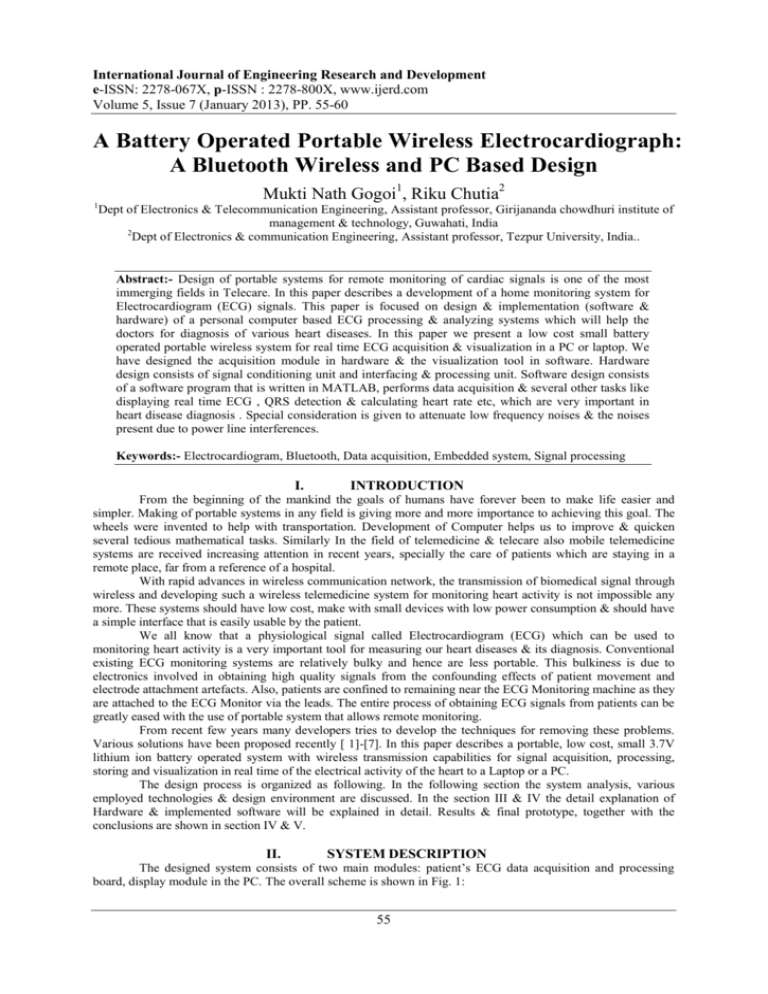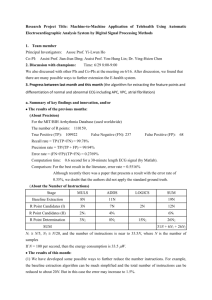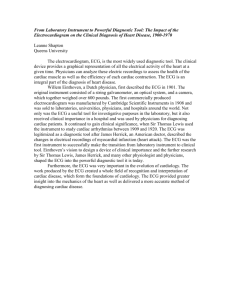A Battery Operated Portable Wireless Electrocardiograph: A
advertisement

International Journal of Engineering Research and Development e-ISSN: 2278-067X, p-ISSN : 2278-800X, www.ijerd.com Volume 5, Issue 7 (January 2013), PP. 55-60 A Battery Operated Portable Wireless Electrocardiograph: A Bluetooth Wireless and PC Based Design Mukti Nath Gogoi1, Riku Chutia2 1 Dept of Electronics & Telecommunication Engineering, Assistant professor, Girijananda chowdhuri institute of management & technology, Guwahati, India 2 Dept of Electronics & communication Engineering, Assistant professor, Tezpur University, India.. Abstract:- Design of portable systems for remote monitoring of cardiac signals is one of the most immerging fields in Telecare. In this paper describes a development of a home monitoring system for Electrocardiogram (ECG) signals. This paper is focused on design & implementation (software & hardware) of a personal computer based ECG processing & analyzing systems which will help the doctors for diagnosis of various heart diseases. In this paper we present a low cost small battery operated portable wireless system for real time ECG acquisition & visualization in a PC or laptop. We have designed the acquisition module in hardware & the visualization tool in software. Hardware design consists of signal conditioning unit and interfacing & processing unit. Software design consists of a software program that is written in MATLAB, performs data acquisition & several other tasks like displaying real time ECG , QRS detection & calculating heart rate etc, which are very important in heart disease diagnosis . Special consideration is given to attenuate low frequency noises & the noises present due to power line interferences. Keywords:- Electrocardiogram, Bluetooth, Data acquisition, Embedded system, Signal processing I. INTRODUCTION From the beginning of the mankind the goals of humans have forever been to make life easier and simpler. Making of portable systems in any field is giving more and more importance to achieving this goal. The wheels were invented to help with transportation. Development of Computer helps us to improve & quicken several tedious mathematical tasks. Similarly In the field of telemedicine & telecare also mobile telemedicine systems are received increasing attention in recent years, specially the care of patients which are staying in a remote place, far from a reference of a hospital. With rapid advances in wireless communication network, the transmission of biomedical signal through wireless and developing such a wireless telemedicine system for monitoring heart activity is not impossible any more. These systems should have low cost, make with small devices with low power consumption & should have a simple interface that is easily usable by the patient. We all know that a physiological signal called Electrocardiogram (ECG) which can be used to monitoring heart activity is a very important tool for measuring our heart diseases & its diagnosis. Conventional existing ECG monitoring systems are relatively bulky and hence are less portable. This bulkiness is due to electronics involved in obtaining high quality signals from the confounding effects of patient movement and electrode attachment artefacts. Also, patients are confined to remaining near the ECG Monitoring machine as they are attached to the ECG Monitor via the leads. The entire process of obtaining ECG signals from patients can be greatly eased with the use of portable system that allows remote monitoring. From recent few years many developers tries to develop the techniques for removing these problems. Various solutions have been proposed recently [ 1]-[7]. In this paper describes a portable, low cost, small 3.7V lithium ion battery operated system with wireless transmission capabilities for signal acquisition, processing, storing and visualization in real time of the electrical activity of the heart to a Laptop or a PC. The design process is organized as following. In the following section the system analysis, various employed technologies & design environment are discussed. In the section III & IV the detail explanation of Hardware & implemented software will be explained in detail. Results & final prototype, together with the conclusions are shown in section IV & V. II. SYSTEM DESCRIPTION The designed system consists of two main modules: patient’s ECG data acquisition and processing board, display module in the PC. The overall scheme is shown in Fig. 1: 55 A Battery Operated Portable Wireless Electrocardiograph: A Bluetooth… Fig. 1. System Description The hardware system developed is consists of three units which will be later separately described. The first unit is a bio-amplifier & a low pass & a high pass filter section. The second unit is communication module and it includes a Bluetooth module. A microcontroller (PIC16F877A [8]) is used to build the processing unit. The microcontroller performs the following functions: it captures & digitizes the ECG signal, establishes the connection to the Bluetooth device & sends the data accordingly with the instructions given in it. The complete hardware unit is integrated in a small PCB using DIPTRACE software environment to make layout on it. In the software design is composed of a small microcontroller code & a MATLAB program. As stated above, the microcontroller code is written with the help of high level language & it is responsible to process the acquired ECG. Similarly The MATLAB program performs the acceptation decoding of the wirelessly transmitted ECG data & performs real time visualization of ECG in a PC or LAPTOP. It also performs the detection of QRS complex and calculation of the patient’s heart rates. Technology Used We have selected Bluetooth as our wireless communication protocol. It is chosen because Bluetooth is a pure adhoc networking protocol [9] used especially for short-range, low power wireless communication radio link between two devices operating in the unlicensed 2.4 GHz industrial scientific and medical (ISM) band[10]. It is also a low cost, very efficient, reliable & lean communication system. A. III. HARDWARE & SOFTWARE DESIGN In the above section, the hardware system, we have presented is the module based design. It is divided into four major parts: Signal acquisition module, Signal processing module, Bluetooth transmission module and Receiver display module (PC or Laptop) as shown in system description. Software design includes a PIC microcontroller program in the signal processing module & MATLAB program in the receiving module. We have shown below in the figure. 2 the detailed block diagram of the system: Fig. 2. System block diagram 56 A Battery Operated Portable Wireless Electrocardiograph: A Bluetooth… Signal acquisition In our design we have used a simple 3- lead ECG system. They are used for sensing bio-electric potentials as caused by muscle and nerve cells. Both clip on type limb & commercial electrodes are used to acquire the raw ECG from the patient’s body. The leads are placed based on Einthoven’s triangle shown in the figure. 3(a). A. Fig. 3. (a). Einthoven’s triangle Structure [11] Fig.3.(b). placement of leads based on Einthoven’s triangle [12] By convention, lead I have the positive electrode on the left arm (LA), and the negative electrode on the right arm (RA), and therefore measure the potential difference between the two arms. In this and the other two limb leads, an electrode on the right leg serves as a reference electrode for recording purposes. As acquired ECG signal is a extremely weak nature (0.5-4mV) & a low frequency signal ranging from 0.05-150 Hz, it is required to use a very high gain (around 1000 dB), high CMRR (>= 100 dB) and 0.05-200 Hz bandwidth differential amplifier to make suitable for further processing. We have selected Burr-Brown INA126P [13], a high precision instrumentation amplifier to meet these requirements. The filtering stage is a band pass filter (combination of a low pass & a high pass filter) to eliminate the muscle artifacts, low frequency noises & the artifacts caused by the movement of electrodes cables. After filtering and amplification, the data is ready to be digitized by the ADC. The ADC requires the signal it is sampling to be contained completely in the positive voltage domain. A summing amplifier is used to achieve this & the topology is as shown in the figure. 4. Bellow. Fig. 4. Implemented summing amplifier Signal Processing & Bluetooth transmission Signal Processing unit is composed of a PIC16F877A microcontroller & a Bluetooth transmission module. PIC16F877A is a 8 bit, Low power, high speed CMOS FLASH/EEPROM microcontroller with build in Universal Synchronous Asynchronous Receiver Transmitter (USART/SCI) module having 9-bit address detection. Also it has 10 bit multi-channel analog-to-digital converter (ADC) within in it. Due to limitations in the transmission rate of the wireless link & MATLAB environment, the sampling rate has to be fairly low when compared to a clinical system, which samples at about 1 kHz. We have selected 300 Hz sampling frequency, with a 10 bit A/D resolution. This is enough to meet Nyquist's criteria for sampling rate. The Bluetooth module used is the AUBTM-20 chip. AUBTM-20 is Bluetooth Core V2.0 compliant module with SPP. It provides application programming interface (API) for communication through the AT commands. It Supports UART,USB, PCM, I2C interface to host system. B. 57 A Battery Operated Portable Wireless Electrocardiograph: A Bluetooth… After configuring the AUBTM-20 transceiver module to the microcontroller, it continuously reads the microcontrollers UART in a interval 3 ms & sends the data wirelessly. Receiving & display module A Personal computer (PC) or Laptop is used as a display device. A USB Bluetooth module connected in the PC recognizes the transmitted digitized wireless signal & reproduces it to form the original ECG signal. The Communication link between Bluetooth module and USB dongle is established by using Terabyte Bluetooth dongle program. The MATLAB programming environment is selected for hosting wireless communication between these two Bluetooth modules. A small program written in MATLAB IDE is responsible for real time visualization of ECG signal & calculating the heart rate of the patient in the PC. The 50 Hz power-line interference is also removed by making simple software notch filter. C. Battery and Power Management For fulfillment of our design goal of a low power system, two 3.7V Lithium Ion batteries are used to make a handy power supply of ± 3.7V which is capable of driving INA126P & LM358N Op-amp chips and PIC16F877A microcontroller. Since Bluetooth chip requires a constant 3.3V to operate, a ASM117 voltage converter is also used. D. IV. RESULTS Successful implementation of the hardware is necessary to obtain a clean ECG signal. Through careful trial and selection of capacitors and resistors Low pass filters & High pass filters are developed that closely match the performance obtained in MicroSim simulations. The designed hardware signal acquisition and processing module is implemented in a small PCB board. As mentioned in the system description the layouts are made using DipTrace. Figure.6. shows the PCB layout of the complete hardware unit. Fig. 6. Complete PCB layout of the hardware unit. All the hardware is implemented on a small PCB. The PCB measures 150 cm by 70 cm and all the copper traces are placed at the Bottom layer of the PCB. All the components are soldered by making the holes created from the top layer to connect the tips of the components. Fig. 7. DSO output of the acquisition module with 50Hz noise. After completion of the signal condition & amplification unit the acquired ECG signals are first tested in a digital oscilloscope. The required amount of amplification of the ECG signal needed for the Microcontroller unit so that its ADC module is able to perfectly digitize the acquired ECG signal, is tested & adjusted prior to give input to the microcontroller with the help of this Oscilloscope unit. It is the exactly same with the raw ECG signal & contains 50 Hz Power line artifact. Figure.7. shows the DSO observation of the raw ECG signal. 58 A Battery Operated Portable Wireless Electrocardiograph: A Bluetooth… Fig. 8. ploting of Real time ECG waveform in MATLAB. All the PIC based and PC software operates correctly. Successful A/D conversion and communication with the other components in the design is evidenced through the eventual signal display on the PC. We have achieved a data acquisition rate of 330 samples/sec, which is enough for recording a fairly accurate ECG. The Terabyte software handled the connection to the ECG sensor system via a Bluetooth virtual serial port. The MATLAB R2007b application for the PC manages the graphical display of the signals as shown in the following figure.8 (b). This is a power line free ECG waveform. Filtering algorithms and heart rate computations have also been implemented. Fig. 9.(a) QRS detection in 12 sec data Fig. 9.(b) ploting of Heart rate of the patient Finally in the following figure. 10. Shows a complete snapshot of the developed low cost portable battery operated wireless home Electrocardiograph system. Fig. 7. The complete system. V. CONCLUSION Hence a low cost portable electrocardiograph system for ECG data acquisition & visualization is developed which is very useful for the patient’s home monitoring or residing in a remote place far from the hospital. The ECG signal was acquired, processed and displayed. The interferences observed in the result is attributed to various types of noises like movement of patient’s body during recording, baseline drifting, mismatch of resistors, 50 Hz power line noise etc. A software 50 Hz notch filter is designed to suppress the 59 A Battery Operated Portable Wireless Electrocardiograph: A Bluetooth… power line interference. The acquired ECG signals bandwidth is determined using high and low pass filters, these filters prevents the high & very low frequency noises from the recording ECG. The system as its name stands is completely functional for the recording of fairly accurate ECG data and reduces wired links through the successful implementation of a wireless technology. Work conducted for this work is in creating circuitry that can obtain an accurate ECG signal, micro-controller based software that digitizes the signal and a PC based user interface that displays ECG signals. This work has resulted in a prototype of small, wireless ECG usable in monitoring an subject without being overloaded by inference from movement and surrounding electronics & large no of wires. Further researchers can also try to build a complete wireless system in which the wired connections between the sensor points & the signal acquisition board can be eliminated. Much functionality could be added to the PC program. Similarly we can add GPRS, SMS, WIFI and perhaps GPS technologies with it to make much more suitable to use. REFERENCES [1]. [2]. [3]. [4]. [5]. [6]. [7]. [8]. [9]. [10]. [11]. [12]. [13]. J.M.Kahn, Randy H. Katz, and K. S. J. Pister. Next century challenges: Mobile networking for ”smart dust”. In Proc. ACM/IEEE International Conference on Mobile Computing and Networking (MobiCom 99), Seattle, WA, August 1999. Transducers ‟97 Chicago: digest of technical papers / 1997 International Conference on Solid-State Sensors and Actuators (9th:1997: Chicago, Illinois) V2, “A Very Low-Power Consumption Wireless ECG Monitoring System Using Body as a Signal Transmission Medium”, Piscataway, NJ: IEEE, pp 1003 – 1006, c1997. ] S. Khoor, J. Nieberl, K. Fugedi and E. Kail, “Telemedicine ECG – Telemetry with Bluetooth Technology”, Computers in Cardiology, vol. 28, pp 585-588, 2001. M. Engin, Y. Yamaner, E. Z. Engin, “A biotelemetric system for human ECG measurements”, Elsevier Measurement, Article in Press, accepted 7 April, 2005. Fadlee M, Rasid A, Woodward B. "Bluetooth Telemedicine Processor for Multichannel Biomedical Signal Transmission via Mobile Cellular Networks". IEEE Transactions on Information Technology in Biomedicine, vol. 9, no. 1, march 2005. M.Elena, J.M. Quero, C.L.Tarrida, L.G.Franquelo, “Design a Mobile Telecardiology system using GPRS/GSM Technology”. Proceeding of the Second Joint EMBS/BMES Conference. Houston Octuber 2002. U. Anliker, J. A. Ward, P. Lukowics, G. Tröster, F. Dolvek, M. Baer, F. Keita, E. B. Schenker, F. Catarsi, L. Coluccini, A. Belardinelli, D. Shklarski, M. Alon, E. Hirt, R. Schnid, y M. Vuskovik, “AMON: A wearable multiparameter medical monitoring and alert system,” IEEE Transactions on Information Tehcnology in Biomedicine, vol. 8, no. 4, pp. 415–427, December 2004. PIC16F877A data sheet available at http://ww1.microchip.com/downloads/en/devicedoc/39582b.pdf Madden, S. Szewczyk, R. Franklin, M.J. Culler, D., “Supporting aggregate queries over ad-hoc wireless sensor networks”, California Univ., Berkeley, CA, USA. Mobile Computing Systems and Applications. IEEE Workshop, pp 49 - 58, June 2002. Wei-Shin Wang, Bluetooth “a new era of connectivity”, IEEE Microwave Magazine, vol 3 Issue: 3, pp 38 -42, Sept. 2002. The Einthoven triangle image available at http://www.nottingham.ac.uk/nursing/practice/resources/cardiology/function/bipolar_leads.php The Einthoven triangle available at .http://www.ni.com/white-paper/11320/en INA126P data sheet available at http://www.ti.com/lit/ds/symlink/ina126.pdf 60








